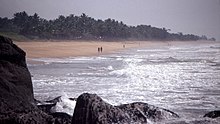San-Pédro
| San-Pédro | ||
|---|---|---|
|
|
||
| Coordinates | 4 ° 45 ′ N , 6 ° 38 ′ W | |
| Basic data | ||
| Country | Ivory Coast | |
| ISO 3166-2 | CI | |
| Residents | 261,616 (2014 census) | |
|
Location of San-Pédro
|
||
San-Pédro is a city (261,616 inhabitants, 2014 census) in the southwest of the Ivory Coast and is located on the Gulf of Guinea about 80 kilometers from Sassandra at the mouth of the San Pedro River. It has the second largest port in the country and is the capital of the Bas-Sassandra district and the San-Pédro department . To the west of the city is the Taï National Park , a UNESCO World Heritage Site .
history
San-Pédro was discovered about 500 years ago by the Portuguese explorer Soeriré da Costa. Until the city was expanded in the mid-1960s, San-Pédro was a small fishing village with just 100 inhabitants.
The city was captured by units of the Forces républicaines de Côte d'Ivoire (FRCI) in the course of the government crisis of 2010/2011 on March 30 and 31, 2011 . As a result, the world market price for cocoa dropped suddenly by 10 percent.
On April 20, 2011, fighting was reported from downtown San-Pédro. One FRCI unit is said to have tried to prevent another from looting. When heavy weapons were used, the United Nations Operation in Ivory Coast (ONUCI) eventually intervened and ended the fighting.
population
| year | 1965 | 1975 | 1988 | 1998 | 2007 |
|---|---|---|---|---|---|
| Residents | ~ 100 | 31,606 | 70,601 | 131,800 | 219.043 |
religion
San-Pédro is the seat of the diocese of San Pedro-en-Côte d'Ivoire .
City structure
There are several geographically and socially separated districts. The business center is the Litiro quarter just under two kilometers north of the port with hotels, restaurants and nightlife. An industrial area extends between the lakes and the San Pédro river. Five kilometers on the road to Daloa is the simple residential district of Le Village with handicraft shops, with the main market a little to the west. An extensive workers' living area made of wooden barracks extends in the vicinity.
A clear contrast to this is the French residential area on the coastal road one kilometer west of the port, with well-tended restaurants along the beaches. The hills around the city are forested.
economy
After the expansion in the 1960s, fishing is an important branch of industry. The fishing port was completely expanded by Japanese investors in the 1970s. But wood production and processing is still the largest employer. But agriculture with products such as cocoa , coffee beans , rubber , cotton and palm oil are other job providers. Since 1995, raw logs are no longer allowed to be exported. Through this law ("felled wood from the Ivory Coast may only be processed within the country") , wood processing in San-Pédro was expanded. Further major investments are currently being made in expanding the cocoa plantations.
port
The port is in a lagoon; to protect it from silting up , the river Hé ou Yé ou San-Pédro was diverted. Between 1968 and 1971 the port was built by a Franco-German consortium. The goal at the time was to be able to bring the exports of wood from the southwest onto the water more quickly. Precious woods such as mahogany , in particular, are still exported to Europe to an extent of over 80%. In addition to the main export goods, fish and wood, cocoa (50% of national production), coffee, cotton and other agricultural products are also exported. The main imports are wheat and rice . The port will be expanded in the near future when the planned railway line to Man is completed. Then the minerals ( manganese , nickel and others) are to be exported from Man via the port of San-Pédro.
Airport
San-Pédro has its own small international airport (DISP / SPY).
tourism
The city is known for its natural beautiful beaches, where you can spend the whole year thanks to the mild equatorial climate. More and more hotels are being built in San-Pédro.
Sports
San-Pédro has a soccer team ( SéWé de San Pedro ) that plays in the Fédération Ivoirienne de Football (1st division).
Web links
Individual evidence
- ↑ Results of the 2014 census . Retrieved January 7, 2016.
- ↑ Dominic Johnson : Gbagbo's regime collapses. In: the daily newspaper . Retrieved April 5, 2011 .
- ^ New battles in Ivory Coast. In: Frankfurter Allgemeine Zeitung . March 7, 2011, accessed March 30, 2011 .
- ^ Fight among the victors in Côte d'Ivoire. In: Neue Zürcher Zeitung . April 21, 2011, accessed April 28, 2011 .






